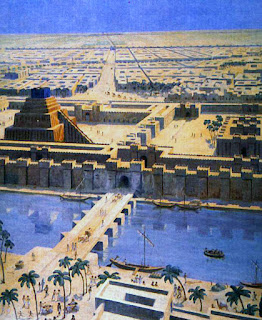Daniel and Yosef
For starters, there are numerous parallels between Daniel in this story and the account of Yosef in Pharoah's court in Genesis. These include:
- Both are taken as captives into a strange land
- Both are given foreign names in place of their Hebrew name
- Both resist sin and assimilation
- Both are granted wisdom and the ability to interpret dreams
- Both appear before the king and impress him with said wisdom to the exclusion of the court magicians
- Both become members of the King's court
These persistent parallels serve to orient the reader. The Book of Daniel is not an island. The foundation is is built on is the classic story of living faithfully in exile, the story of Yosef in Egypt. The Book of Daniel will go on to explore the same themes and expand on them. This is to the benefit of it's intended audience, the many subsequent generations of Jews who live as subjects of foreign powers. So what insights does Daniel 1 add on top of the Yosef story?
The Holy and the Profane
There are some apparently irrelevant details in verse 2 when describing Yehoyakim's defeat by the Babylonians:
וַיִּתֵּן אֲדֹנָי בְּיָדוֹ אֶת-יְהוֹיָקִים מֶלֶךְ-יְהוּדָה, וּמִקְצָת כְּלֵי בֵית-הָאֱלֹהִים, וַיְבִיאֵם אֶרֶץ-שִׁנְעָר, בֵּית אֱלֹהָיו; וְאֶת-הַכֵּלִים הֵבִיא, בֵּית אוֹצַר אֱלֹהָיו
I'd like to suggest another possible reason for the mention of the temple vessels. The reader is meant to draw a parallel between the captive vessels in verse 2 and the captive youths in verse 3. Just as the holy vessels from Beit Hamikdash are being desecrated by being brought into a house of idolatry, so to are these noble Judean youths being desecrated by being indoctrinated into Babylonian culture.
This theme of desecrating the holy is further emphasized in verse 7, when the boys are given new Babylonian names:
וַיָּשֶׂם לָהֶם שַׂר הַסָּרִיסִים, שֵׁמוֹת; וַיָּשֶׂם לְדָנִיֵּאל בֵּלְטְשַׁאצַּר, וְלַחֲנַנְיָה שַׁדְרַךְ, וּלְמִישָׁאֵל מֵישַׁךְ, וְלַעֲזַרְיָה עֲבֵד נְגוֹ
What happens to the four companions' Hebrew names? Names that proclaim the glory of God:
- Daniel- God Judges
- Hananya- God is Gracious
- Mishael- Who is like God?
- Azarya- God Helps
The boys are instead given names of Babylonian Gods:
- Beltshazar for Marduk
- Shadrach and Meshach for the Moon God
- Abed Nego for Nergal
Just as the temple vessels are profaned with idolatry, so are the four Jewish youths profaned with idolatrous names.
Of Vessels and Vassals
Yet Nebuchadnezzar's irreverent plan immediately goes off the rails. In verse 8 Daniel makes a decision not to eat the non-kosher meat and wine provided to the King's servants:
וַיָּשֶׂם דָּנִיֵּאל עַל-לִבּוֹ, אֲשֶׁר לֹא-יִתְגָּאַל בְּפַת-בַּג הַמֶּלֶךְ וּבְיֵין מִשְׁתָּיו; וַיְבַקֵּשׁ מִשַּׂר הַסָּרִיסִים, אֲשֶׁר לֹא יִתְגָּאָל
 Daniel and his companions refuse to allow themselves to be profaned by their immersion in Babylonian language and culture. They are careful not to ingest impure food and they presumably hold themselves aloof from other parts of Babylonian culture. God's response to their dedication is both immediate and substantial. They are blessed and quickly become the wisest advisors in the kingdom.
Daniel and his companions refuse to allow themselves to be profaned by their immersion in Babylonian language and culture. They are careful not to ingest impure food and they presumably hold themselves aloof from other parts of Babylonian culture. God's response to their dedication is both immediate and substantial. They are blessed and quickly become the wisest advisors in the kingdom.וְהַיְלָדִים הָאֵלֶּה אַרְבַּעְתָּם, נָתַן לָהֶם הָאֱלֹהִים מַדָּע וְהַשְׂכֵּל בְּכָל-סֵפֶר וְחָכְמָה; וְדָנִיֵּאל הֵבִין, בְּכָל-חָזוֹן וַחֲלֹמוֹת...וְכֹל, דְּבַר חָכְמַת בִּינָה, אֲשֶׁר-בִּקֵּשׁ מֵהֶם, הַמֶּלֶךְ--וַיִּמְצָאֵם עֶשֶׂר יָדוֹת, עַל כָּל-הַחַרְטֻמִּים הָאַשָּׁפִים, אֲשֶׁר, בְּכָל-מַלְכוּתוֹ
Daniel chapter 1 carries a powerful message to Jews living in times of exile. Yes, the Babylonians succeeded in capturing and profaning holy vessels of the temple, but people are not vessels. People can ultimately choose whether to allow themselves to be profaned or to retain their sanctity. And God himself will bless those who choose the more difficult path.










